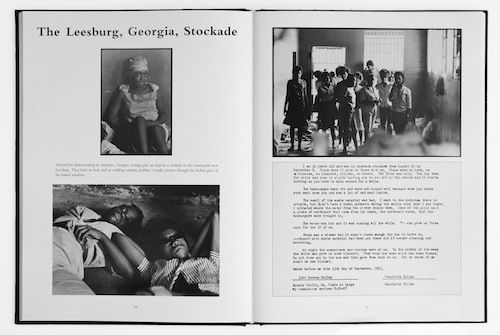Memories of the Southern Civil Rights Movement
by Danny Lyon
Twin Palms, 2010
Reviewed by Ellen Rennard
In 1962 Danny Lyon, at age 20, still a student at the University of Chicago, packed two cameras in an army bag and headed south, where for two years he worked as the staff photographer for the Student Nonviolent Coordinating Committee (SNCC), a group that played a pivotal role in the civil rights movement. Its members were, in Lyon’s words, “believers in freedom in the highest sense of the word.”
In his book Memories of the Southern Civil Rights Movement, Lyon brings to life that movement and its promise through photographs and text as well as reproductions of original documents such as letters, minutes of meetings, and flyers, many of which are from Lyon’s archive. Seeing Lyon’s eloquent photographs alongside these primary materials grounds the book in the rich loam of truth.
The first chapter sweeps quickly through the years 1955-1961, providing the back-story to Lyon’s involvement in SNCC. It’s dense with acronyms as well as names, so it takes a while to traverse the landscape. Read on. By the second chapter, Lyon arrives in Cairo, Illinois, where he photographs a group demonstrating in front of the town’s only, and segregated, swimming pool. He tells the story of a defiant thirteen-year-old girl who stood her ground until a truck knocked her down. By the time I turned two more pages and saw Lyon’s powerful photograph of drinking fountains in the county courthouse of Albany, Georgia (a large one marked “white,” a tiny one marked “colored”), I was transported.
There’s an unvarnished spontaneity in Lyon’s photographs of the movement’s leaders, speechmakers, and organizers. His images bear witness to the uncelebrated people who marched in protests, registered to vote for the first time, endured jail, and risked their lives, or even lost them. He reminds us of the 14,000 people arrested in the south between May and September of 1963. We see the crowds waiting along the funeral route of the four girls who were killed in the bombing of the Sixteenth Street Baptist Church in Birmingham, the blown out windows of the church itself, and the heavily armed members of the Alabama Highway Patrol.
There is a slight loss of momentum in the last few chapters of the book, beginning in the fall of 1964, after Lyon no longer worked as the staff photographer for the SNCC, but this section does provide a necessary sense of completion. Most importantly, as a whole this book honors those who effected real, meaningful change by ending segregation in the South. It provides a window on an extraordinary time in American history. At the same time, Lyon alludes to the equality that has not yet been achieved. He explains: “I made [the book] because SNCC, particularly in the early years, is a model for any group that wants to turn America into what it could be, but is not. I made it for us all.”
Originally published in 1992 by the Center for Documentary Studies at Duke University and the University of North Carolina Press, Memories of the Southern Civil Rights Movement has been reissued by Twin Palms Publishers, with new texts and an afterword by Congressman John Lewis, in honor of the fiftieth anniversary of SNCC.
Ellen Rennard is a Groton, MA based photographer and teacher.
To view some of Ellen's photography, please visit her website.
To order the book, please visit the Twin Palms website.



